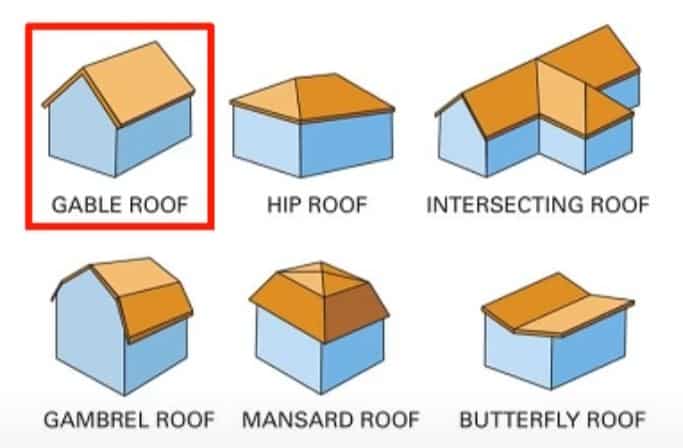A gable roof is a type of roof that has two sloping sides that rise to meet in the middle, in an “A” shape. The sides of a gable roof are referred to as the ‘gable’ and the point where they meet is called the ‘peak’. Named after architect, Joseph M. Gwilt, their design uses the triangular shape of the gable to provide strength and rigidity when building roofs. This provides strength whilst keeping their sizes small.
These roofs are traditionally used for farm buildings. They are named after their resemblance to the triangular gable, which is the visible face of the pitched roof that extends beyond the walls it supports.

Gable roofs are the classic American style of homes, also called Arts & Crafts style, that have can be found in homes built since the late nineteenth century.
Benefits and Purpose of a Gable roof
Gable roofs are a beautiful addition to any home. They add character, function, and style. They add a touch of elegance, especially if you install skylights. Installing a Gable roof adds to the resale value of your home, especially in today’s real estate market. Here are some additional benefits of a gable roof:
- Are easy to construct
- can have raking ceiling inside giving a nice high ceiling space
- They are a design feature for aesthetics
- Can have attic storage space
Negatives of a Gable roof
While a gable roof is a great roof it was once considered more aesthetically appealing. However, over the last few decades, it has been largely replaced by other roof shapes, such as the Hip roof.
- Not great in windy areas
- Not as popular as they once were
- don’t provide an eaves and shade to windows at the front of the gable
Types of Gable Roofs
There are a number of gable roof designs that homeowners can choose from. The type of roof you select will depend on your personal preference and the size, shape or slope of your home’s exterior walls

What is a Dutch Hip Gable?
A Dutch gable is also known as a Gambrel and Gablet roof is a mix between a hipped roof and a gable roof. It is usually associated with Dutch architecture in North America, however, it can be found throughout the world in places like Australia as a design feature to make a normal hipped roof more appealing.
What are the advantages of Dutch Gables?
Dutch gables are used more so for decoration rather than function, but they can still provide some benefits if designed correctly. The first thing that comes to mind when it comes to Dutch gables is roof overhangs, which are also referred to as eaves. Eaves are used by Dutch gables to protect the exterior of the house and shade on the front windows compare to a traditional gable.

Flemish Gable
A Flemish gable is related to a dutch gable sometimes but this is not really correct. It only seems to be used when the roof slopes are actually flared outward at the bottom. When the roof slopes are simply cut off straight across, it is called a Dutch gable. A Dutch gable is also referred to as an inverted Flemish gable because it has two pitch faces whereas the Flemish gable only has one pitch face.
What is a cross gable roof?
A cross gable is a structure that has two roofs with different pitches along the length of the same face. One roof runs perpendicular to the other and they meet together at a ridge or peak. A cross gable is often seen in the design of a house. People will often build cross gables over windows or doors to give the structure a more interesting look.
Difference between a Gable and a Hip Roof
A gable roof has a ridge and two sloping planes on either side of the ridge making a triangle shape. A hip roof is more difficult to visualize, but it is basically a sloped plane on all four sides of a building with no ridges or valleys.

A gable roof is basically a low pyramid shape with two sloping planes, nothing more than that whereas a hipped roof can be very complex due to the way it has eaves around all sides of the building and the eaves are all at the same height from the floor level.

